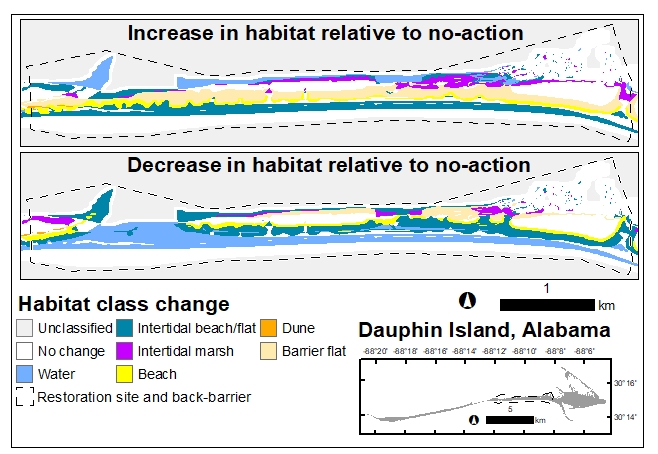Barrier islands are dynamic environments that can evolve with currents, waves, and tides. These systems help with storm surge reduction and wave attenuation but accelerated sea-level rise and more frequent and intense storms are expected to drastically change these islands in the future. Although many habitat change studies have evaluated habitat shifts by examining net change over time, understanding spatial dynamics can also be important.
To fully capture the dynamic nature of barrier islands, a team of USGS researchers utilized an existing approach called change component analysis. This approach can quantify habitat oscillation, which is change that does not contribute to overall net gain or loss of a specific habitat. The team applied this tool to predicted habitat maps generated from a previously published habitat modeling effort that utilized numerical model outputs of potential geomorphology. The objective of this initial study was to assess climate change effects on habitat distribution with and without various restoration measures on Alabama’s Dauphin Island. One finding from the assessment was that there were more extensive changes without a beach and dune restoration. This new work built on those results by explicitly quantifying how the study area changed under the modeled scenarios. The results showed that much of the modeled change that occurred was spatially complex—with habitat oscillations and shifts in habitat types that were masked when only the total gains and losses of individual habitat types were considered. An example of a habitat oscillation would be when the habitat type of one area changes (such as from beach to dune) while the reverse change occurs in another area, there would be no net change between the two categories.
The additional information provided by change component analysis—whether applied to historical and contemporary habitat maps or to predicted habitat maps generated by models—may provide land managers with nuanced observations needed to evaluate the efficacy of restoration activities and assist with complex natural resource management decisions on dynamic barrier islands.
https://doi.org/10.1007/s12237-021-00971-w
https://doi.org/10.3133/ofr20201003

Comparison of habitat prediction for the restoration site and back-barrier area on Dauphin Island, Alabama, for future with and without restoration action after a 10-year simulation. The simulation included a static sea-level change of 0.96 m and predicted decadal geomorphic evolution with simulated storms.

